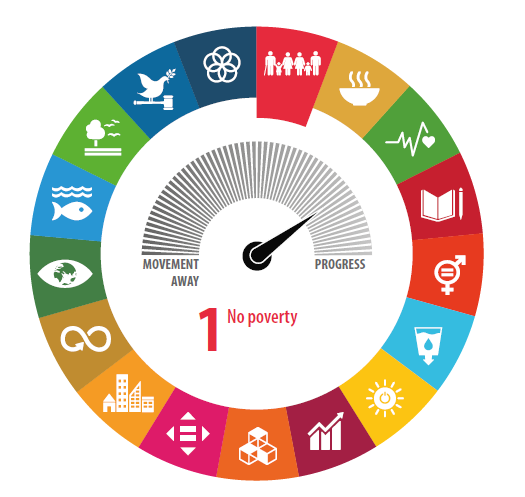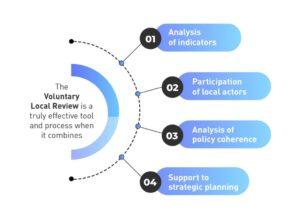SDG progress
SDG progress

Why in news? Bhopal has become the first city in India to join the growing global movement on localisation of Sustainable Development Goals (SDGs) following the release of its Voluntary Local Review (VLR).
Highlights:
About SDGs
- In 2015, the 193 member-states of the United Nations adopted the 2030 Agenda for Sustainable Development, which consists of 17 Sustainable Development Goals and 169 targets as a plan of action for ‘people’, ‘the planet’, and ‘prosperity’.
- The resolution specifies mechanisms for the monitoring, review, and reporting of progress as a measure of accountability towards the people. To this end, member-states submit a Voluntary National Review (VNR) to the UN’s High Level Political Forum (HLPF), and, more recently, VLRs as a means for driving and reporting local implementation of SDGs at the sub-national and city levels.
India’s progress
- India has made commendable efforts towards the adoption, localisation, and achievement of the SDGs.
- NITI Aayog presented India’s second VNR at the HLPF convened in 2020. India’s Ministry of Statistics and Program Implementation (MoSPI) has published a National Indicator Framework (NIF) for the review and monitoring of the SDGs, which contextualises the UN’s Global Indicator Framework to represent India’s unique development journey.
- As noted in a NITI Aayog report, at least 23 States and Union Territories have prepared a vision document based on SDGs. Almost all of them have initiated steps to localise the SDGs. However, it has taken a while to get to India’s first Voluntary Local Review at the city level since the efforts to localise the SDGs began.
- Cities are the most important stakeholders in Agenda 2030 as at least 65% of the 169 targets could not possibly be achieved without the engagement of local urban stakeholders
India’s progress towards achieving SDGs so far
- SDG 1 (No Poverty): India has made significant progress in reducing poverty, with the poverty rate declining from 21.9% in 2011-12 to 4.4% in 2020. The government’s efforts to provide financial inclusion and social protection schemes have contributed to this progress.
- SDG 2 (Zero Hunger): India has made progress in reducing hunger, with the prevalence of undernourishment declining from 17.3% in 2004-06 to 14% in 2017-19.
- SDG 3 (Good Health and Well-being): India has made progress in improving maternal and child health, with maternal mortality ratio declining from 167 per 100,000 live births in 2011-13 to 113 in 2016-18.
- SDG 4 (Quality Education): India has made progress in improving access to education, with the gross enrolment ratio for primary education increasing from 93.4% in 2014-15 to 94.3% in 2019-20.
- SDG 5 (Gender Equality): India has made progress in improving gender equality, with the sex ratio at birth increasing from 918 in 2011 to 934 in 2020.
What is Voluntary Local Review (VLR)?
- A VLR is a tool to demonstrate how local actions are leading the way in equitable and sustainable transformations for people and building a coalition of partners towards this endeavour.
- While it is desirable to align a city’s VLR to the State-level action plan (where available) and the country’s VNR, the process allows a great deal of flexibility to the cities to tell their story within a framework of their choice.
- The cities could choose their priority for the VLR process, articulating it either in terms of a quantitative assessment using various city level indicators relevant to the SDG targets or a narrative that describes the efforts and vision of the city.
What are the benefits of a Voluntary Local Review for local contexts ?
- VLRs help communities and local decision-makers to focus on the areas that require most effort and direct future choices and future funding;
- It translate the SDGs into concrete social solutions and provide a global language to local issues, through the lens of the SDGs;
- It offer public administrations a cognitive tool to break down silos and facilitate dialogue;
- VLRs involve citizenship and civil society in a transparent and participatory way;
- VLRs foster dialogue with other territorial realities at international level and help in becoming part of a global movement to localise the SDGs;
- It constitute a starting point for the process of monitoring local actions
How to make the Voluntary Local Review a truly effective tool?

Challenges faced by the cities:
- A daunting task for Indian cities, particularly the non-metro urban local bodies, with limited capacity, resources, and disaggregated data to do a comprehensive VLR covering all SDGs. Therefore, a VLR does not have to be exhaustive in quantifying each of the 286 indicators under India’s NIF, which translate the global targets under the 17 SDGs into local indicators at the national level.
What can be done?
- Cities may choose specific SDGs for a detailed review as per their priority and logistical comfort. While doing so, they may adapt and further localise the national indicators under the relevant SDGs to reflect the city level realities. Globally, many cities choose to align their review with the SDGs that are taken up for detailed review by the HLPF in its ongoing cycle.
The Bhopal plan
- Bhopal’s VLR is the result of a collaboration between the Bhopal Municipal Corporation, UN-Habitat, and a collective of over 23 local stakeholders.
- It has mapped 56 developmental projects to the SDGs across the three pillars, of ‘people’ (SDGs 1,3,4,5), ‘planet’ (SDGs 6,13,15) and ‘prosperity’ (SDGs 7,8,11).
- The objectives of building basic infrastructure and resilience emerge as a priority for the city from the number of projects mapped to the SDGs.
- The in-depth quantitative assessment of city-level indicators under SDG 11 (Sustainable cities and communities) records Bhopal’s stellar performance in solid waste management practices, public transportation, and open spaces per capita.
It is a remarkable opportunity for Indian cities to tell their stories in their own vocabulary, using a framework of their choice to forefront their work at a global platform. We hope more Indian cities will follow Bhopal’s lead, to showcase urban innovations and collaborations emerging from India on the global map.

